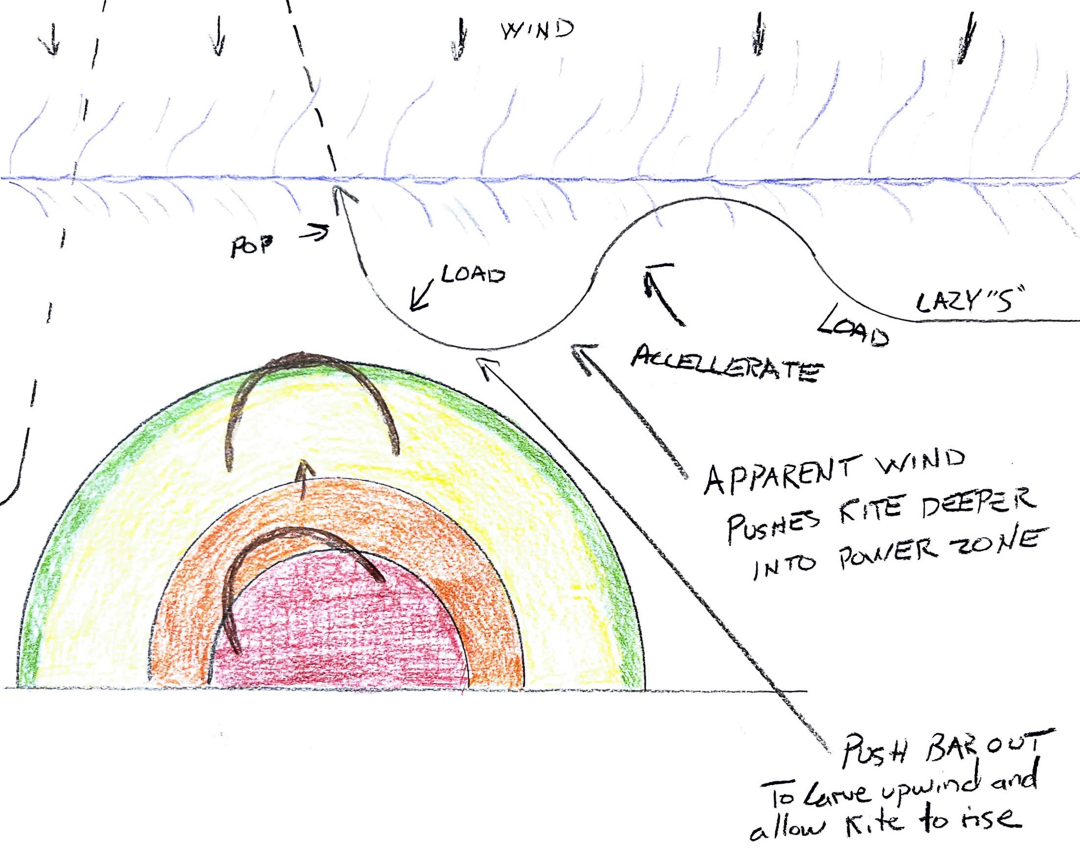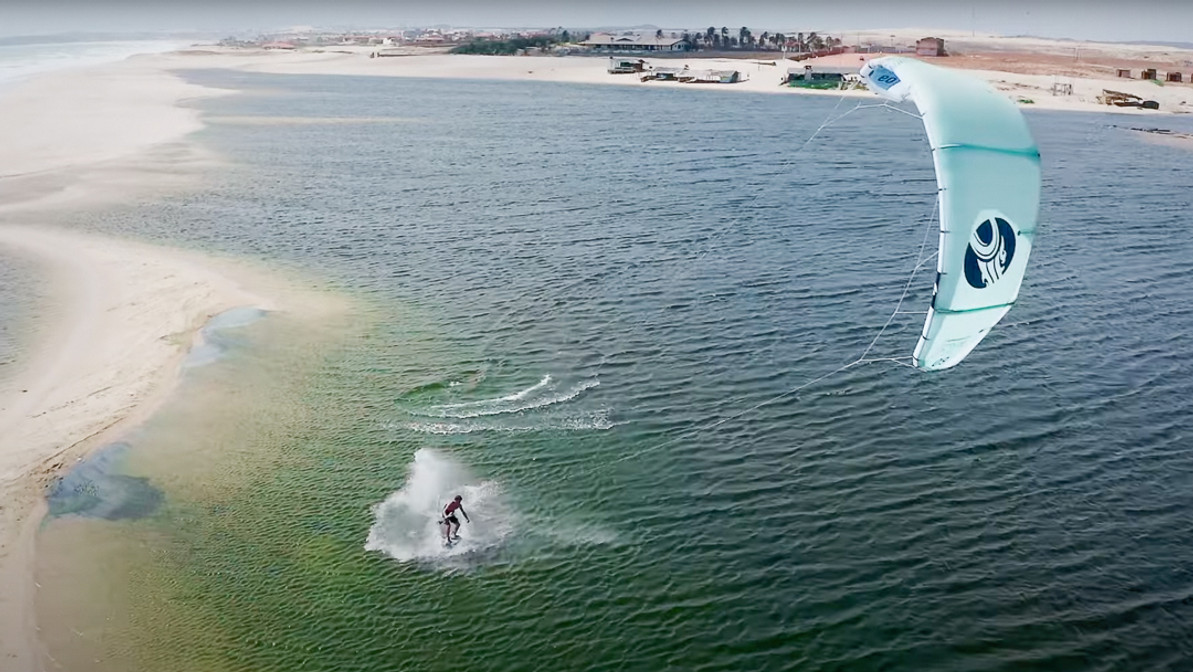How to Jump Higher With the J-Hook and Lazy-S Kiteboarding Techniques

Make Your Kiteboarding Jumps Even Higher With the J-Hook Technique
I've been coaching some friends on how to boost higher while kiteboarding. Most people use a J-Hook (carving upwind to load the rail) to pop. I find that the Lazy-S (carving upwind, but instead of popping, you carve downwind using the increased power to accelerate) makes much more power.
But first, let's talk about using the J-Hook to transition to the Lazy-S.
The first thing I say is that you are not being pulled by a kite—you are the kite! When riding, think of yourself as a bird.
Birds flap their wings but never coast or soar by holding their wings down. This is similar to when you're pulling and holding in your control bar, holding the bar in for more than 3 seconds will stall your kite, and pushing allows you to pull in again.
On the way up, you must start pushing the bar out. It lifts even more in the open position and stalls after 3 seconds if you pull the bar all the way in.

The standard kiteboarding jump happens by sending the kite and carving upwind, in a "J" shape." As you start carving upwind, the motion loads the kite, and you must pop/release the edge before the kite rips you up, or else you lose most of the power.
Your pop is not so much about how hard your legs spring up as the importance of the timing for releasing the edge of the board. Your pop is more about initiating how your body will fly through the air in order to have a good landing.
You will get more boost if, when you are sending the kite up, you pull the bar, turn aggressively, then push the bar back out while carving upwind. Then pull the bar a split second before the pop.
Do this a bit with the J Hook.
You will find that pushing the bar out actually gets you jumping higher with softer landings because you can pull the bar in and out several times. If you pull in one more time just before touching the water, you will get butter-smooth landings.
Just like birds, when they are soaring with their wings wide open—they only flap them down for a moment.
When I do the J Hook, I take the backhand off the bar upon liftoff, so I can't send the kite past 12 o’clock. If your kite passes 12, then when the kite is going backward while I'm going forwards, and the two forces oppose each other. It kills my forward motion, and the tension between the kite and me cancels the power.
So instead, I release the back hand, grab the tail and pull it under my hips to point the nose straight downwind. Because all big jumps have a downwind landing, and if you land sideways to the pull of your kite, you’ll either have a very hard landing or a crash.
This method is without a kiteloop and is for training on loading and flapping your wing. I suggest you try this practice a few times before starting to work on the Lazy-S.

Take Your Kiteboarding Jumps Even Higher Yet, With the Lazy-S Technique
While doing the J-Hook, you can feel the kite loading up as you carve upwind before the pop. Instead of sending the kite and popping, carve back downwind. You will accelerate, and the kite will fall further back in the window. Before your acceleration reaches top speed, pull the bar, send the kite, sheet out, carve upwind, and pull in the bar as you pop.

At this point, you are in a state of acceleration, and the physics is exponential rather than linear. Since the kite dropped back deep in the wind window, it went from nearly straight downwind to 12 instead of hitting the edge.
Straight downwind positioning is more powerful. The Lazy-S changes the forward motion from linear to exponential, adding to that increased power.
After fine-tuning all the variables, this movement may have you doubling your current boost height.

How To Perform The Lazy-S
To start, try the Lazy-S without popping, so you can determine how sharp to carve for maximum acceleration. This also lets you understand your timeframe of acceleration before you reach a static constant speed.
Do this in the glassy section in front of the wave in the trough between it and the wave in front of it.
After finding the sweet spot for maximum acceleration, start doing Lazy-S pops without sending the kite. Park the kite at 45 degrees so you can eliminate all the variables except for the S-shape. Since you won't be going huge, you'll be able to focus on details and watch how the kite falls back deep in the window.
As you begin to put all the pieces together, try not to add kite loops until you've become very consistent with your maneuvers.
A friend of mine progressed from 11 meters to 18 meters in a matter of weeks using the Lazy S, and he eventually broke 20 meters. This is all based on the simple physics and geometry applied to our sport.

As you start jumping higher, you’ll reach a point where you risk a “pendulum” swing under your kite, which can cause it to invert. This is when you’ll have to start kite-looping to keep the kite powered, and downwind of you, so you don’t fall out of the sky. But kiteloops are a different lesson.
Good luck! Wear a helmet and impact vest, please. Make sure to boost at least 100 meters from the shore, but not more than 200, so your friends can rescue you if you crash hard.

Recent Posts
-
Light Wind Kiteboarding Magic? The Reedin WhisperModel Might Be the Answer
Jeff from MACkite had a chance to meet up with Kevin Langeree of Reedin in Cape Town, South Afri …22nd Apr 2025 -
Hot New Releases: MACkite Brand Parawing & Mystic Majestic Ex Custom Harness
MACwing v.5 Beta Single Skin Single Use Jake and Ryan from MACkiteboarding unveiled an excit …1st Apr 2025 -
Code Foils 1250R, with Josh Ku and James Casey | Training, Gliding, and Light Wind Downwinding
Introduction: The Rise of the 1250R The Code Foils 1250R is the latest and largest addition to Co …1st Apr 2025




